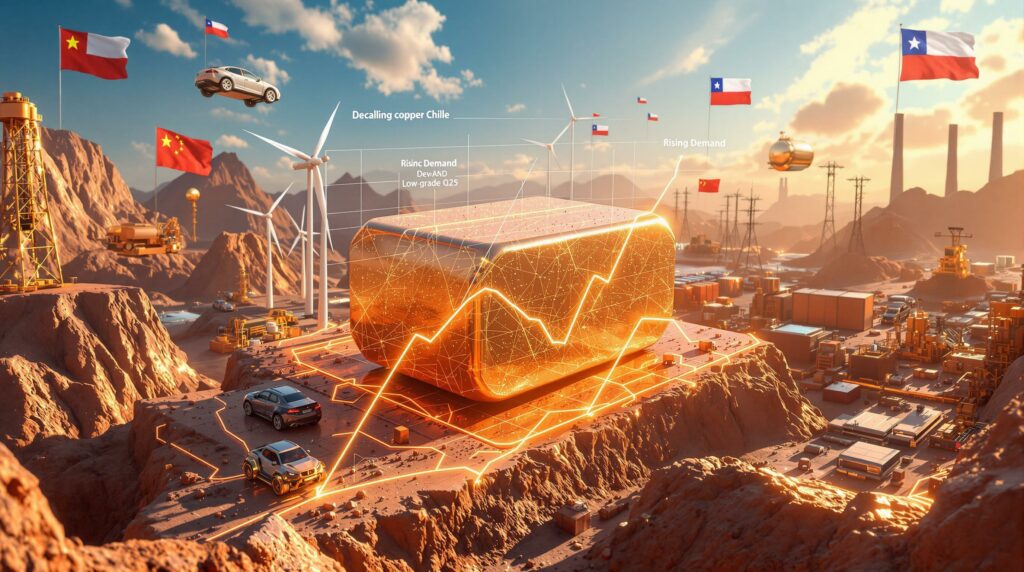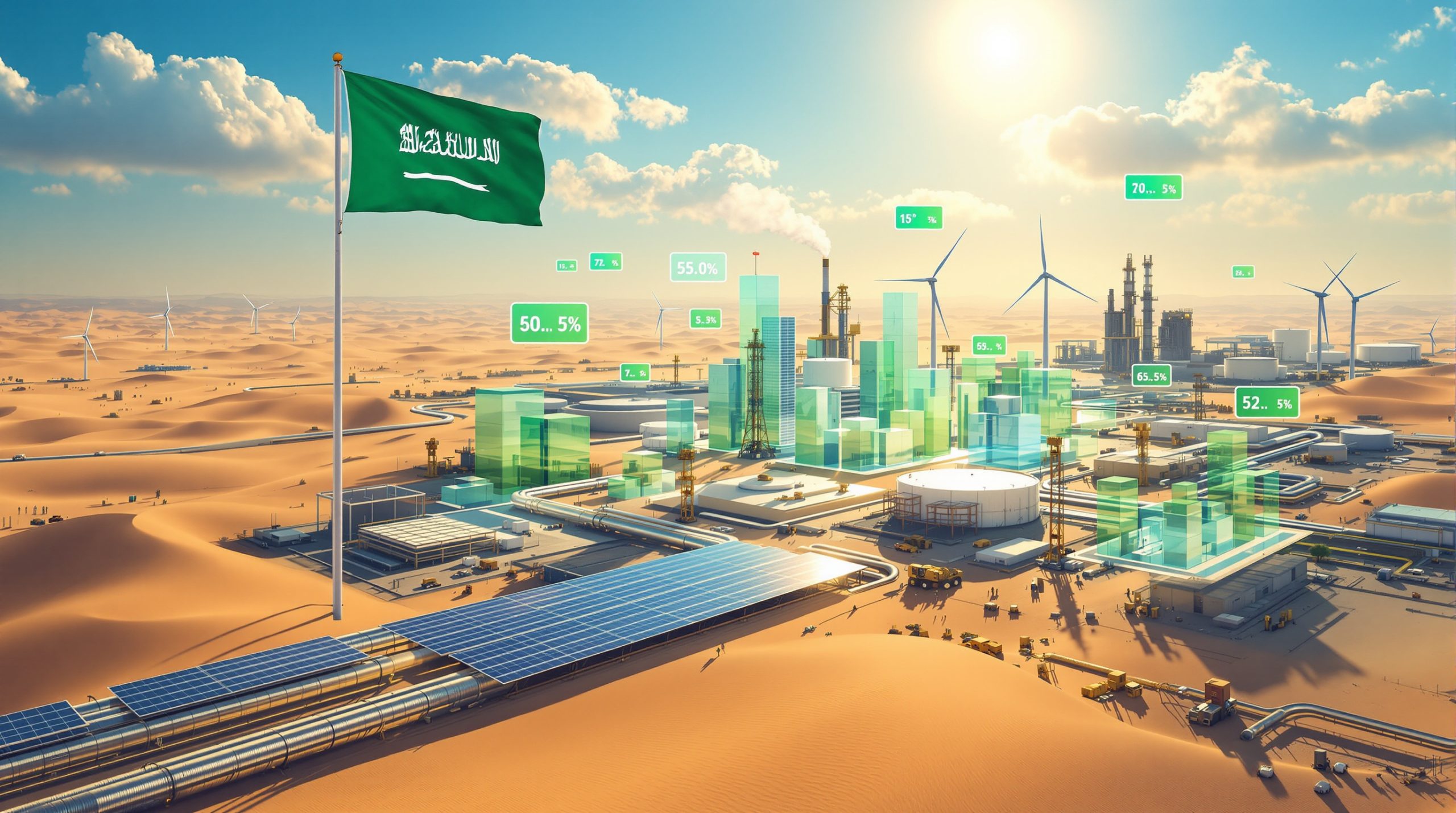What Are the Current Challenges in Global Copper Supply?
Declining Ore Grades and Extended Development Timelines
Copper miners worldwide face significant headwinds as ore grades have plummeted by 40% since 1990. This dramatic decline increases production costs and expands environmental footprints at operations globally. The industry must process substantially more material to produce the same amount of copper, creating efficiency challenges across the value chain.
Development timelines have simultaneously stretched to an average of 16.3 years from discovery to production. This lengthy process reflects growing regulatory complexity, more rigorous environmental requirements, and extensive community engagement processes that have fundamentally altered how new copper projects advance.
Mine production growth is projected at just 2.3% in 2025 (approximately 23.5 million tonnes) and 2.5% in 2026, highlighting the struggle to bring new supply online despite strong price signals. The combination of declining grades and extended timelines creates structural copper supply and demand constraints that market forecasts often fail to fully capture.
Geographic Concentration and Geopolitical Risks
Global copper production has become increasingly concentrated in politically sensitive regions, adding substantial supply risk to market projections. While Chile and Peru maintain their positions as dominant producers, China's strategic expansion in refined copper processing has transformed global trade flows.
China's refined copper production is projected to increase by 7.5-12% annually through 2025, potentially raising its global market share to 57%. This concentration creates systemic vulnerabilities related to trade policy shifts, environmental regulations, and geopolitical tensions that could rapidly disrupt global copper supply.
As Tim Moody, CEO of Pan Global Resources, notes regarding the strategic advantage of high-grade deposits: "When you put all those things together it means that the net value of that 1% or half percent copper at La Romana is worth a lot more than all the other mines and as far as we can tell other advanced projects in the Iberian Pyrite Belt."
How Is Copper Demand Evolving in the Energy Transition Era?
Clean Energy Infrastructure Requirements
The global energy transition represents the most significant demand catalyst in copper's modern history. Grid infrastructure investments are approaching $400 billion in 2025 alone, driving copper consumption of approximately 12.5 million tonnes. This demand is projected to reach 14.9 million tonnes by 2030 as renewable energy deployment accelerates worldwide.
Wind and solar installations require substantially more copper per megawatt than conventional power generation, creating structural demand growth that operates independently from traditional economic cycles. A utility-scale solar installation requires approximately 5.5 tonnes of copper per megawatt, compared to just 1.2 tonnes for a natural gas power plant.
This transition-driven demand operates largely independently from traditional economic indicators, making it less responsive to interest rate adjustments or conventional monetary policy. Even during economic slowdowns, grid infrastructure development continues as countries pursue energy security and decarbonization goals.
Electric Vehicle Manufacturing Expansion
Electric vehicle production has emerged as a critical copper demand driver, with EV-related copper consumption projected to increase from 1.2 million tonnes in 2025 to 2.2 million tonnes by 2030. This near-doubling reflects both increased vehicle production volumes and the copper-intensive nature of EV technology.
A typical electric vehicle requires approximately four times more copper than a conventional internal combustion engine vehicle, with requirements ranging from 83kg for a standard battery electric passenger car to over 183kg for electric buses. This copper is distributed across battery systems, motors, inverters, wiring harnesses, and charging infrastructure.
Global copper usage growth has been revised to 2.4% for 2025 and 1.8% for 2026, with the transportation sector representing an increasingly significant portion of total demand. While consumer EV adoption rates may fluctuate with economic conditions, manufacturer commitments to electrification remain firm, supporting long-term copper price forecast projections.
Data Center and AI Infrastructure Growth
The artificial intelligence revolution has created an entirely new demand category for copper through data center infrastructure expansion. High-performance computing facilities require extensive copper wiring, cabling systems, and cooling infrastructure, creating demand that barely registered in forecasts from five years ago.
Each new generation of AI infrastructure demands greater computational power, higher cooling requirements, and more robust electrical systems—all copper-intensive applications. A single large-scale AI data center can contain over 1,000 tonnes of copper in its electrical systems, cooling infrastructure, and connectivity components.
Major technology companies are investing billions in AI data centers, with copper requirements per facility increasing substantially with each generation of technology. This demand vector operates independently from both traditional economic cycles and energy transition initiatives, creating additional complexity in forecasting total copper supply and demand constraints.
What Do Current Market Dynamics Reveal About Copper's Future?
Supply-Demand Balance Complexities
While some industry forecasts suggest modest market surpluses of approximately 500,000 tonnes over 2025-26 (with 280,000 tonnes in 2025 and 209,000 tonnes in 2026), physical market conditions tell a different story. Regional constraints, logistical imbalances, and inventory discrepancies between major markets create a more nuanced reality than headline figures suggest.
Refined copper output growth is projected at 2.9% in 2025, slowing to just 1.5% in 2026, which barely keeps pace with consumption growth. The disconnect between warehouse inventories in different regions reflects broader trade dynamics and currency effects that influence real supply availability.
Physical premiums widening in Shanghai amid futures market backwardation signal immediate supply tightness that may not be captured in longer-term forecasting models. These market signals suggest that despite projected surpluses, accessible copper supplies remain constrained in key consumption centers.
Price Trajectory Indicators
Major financial institutions, including JPMorgan, project copper prices reaching $10,400-11,000 per tonne by 2025-26, reflecting multiple converging factors:
- Expected tariffs and trade policy adjustments
- Tightening refined supply conditions
- Structural demand growth from electrification
- Declining treatment charges signaling concentrate market tightness
These price projections reflect fundamental copper supply and demand constraints rather than speculative positioning. The increasing divergence between regional markets suggests potential for price volatility alongside the broader upward trend, creating both risks and opportunities for market participants.
Treatment Charge Trends
Treatment and refining charges (TC/RCs) have declined sharply, reflecting intense competition for concentrate feedstock. This decline signals fundamental tightness in the concentrate market that extends beyond cyclical factors into structural undersupply.
For investors, declining treatment charges often precede significant price appreciation cycles, as they indicate smelters' willingness to accept lower processing margins to secure raw material inputs. This metric provides an early indicator of market tightness that may not yet be fully reflected in spot prices.
The severity of recent TC/RC declines suggests that concentrate shortages may persist longer than refined metal imbalances, creating potential opportunities in upstream mining investments versus midstream processing or downstream fabrication.
What Opportunities Exist in the Secondary Copper Market?
Recycling Growth Potential
Secondary copper from recycling totaled 4.55 million tonnes in 2023, with modest growth of 1.5-1.75% projected for 2024. However, acceleration to 6.4% annual growth is expected by 2026 as improved collection systems and processing technologies come online.
This acceleration highlights recycling's critical role in meeting future demand and creates investment opportunities in recycling infrastructure, urban mining technologies, and companies with strategic positions in scrap supply chains. By 2030, secondary sources could provide up to 35% of global copper supply, up from approximately 30% today.
The recycling sector's growth potential extends beyond simple volume expansion. Advanced recycling technologies, improved collection networks, and regulatory support for circular economy initiatives position secondary copper as a strategic growth sector within the broader copper investment landscape.
Urban Mining and E-Waste Recovery
Urban mining—the systematic recovery of metals from end-of-life products and infrastructure—represents a growing opportunity in copper markets. E-waste contains significantly higher copper concentrations than most primary ores, creating economic incentives for recovery as primary grades decline.
A typical circuit board contains 15-20% copper by weight, compared to primary ores that average less than 0.6% globally. This concentration differential creates compelling economics for recovery operations, particularly as processing technologies improve.
Technological innovations in automated disassembly, chemical recovery processes, and logistics optimization are improving recovery rates and economics. Companies developing these technologies may offer exposure to copper price appreciation with reduced mining-related risks and lower environmental footprints.
How Are Exploration and Development Strategies Evolving?
Near-Surface, High-Grade Deposit Focus
The industry is increasingly prioritizing near-surface, high-grade deposits in stable jurisdictions. These assets offer faster development timelines, lower capital requirements, and reduced technical risk compared to complex, deep-mining operations.
Jason Bontempo, CEO of Gladiator Metals, articulates their targeting strategy: "We're targeting over 100 million tons at above 1% copper, not including any credits… Every time you do a site visit and you get out the truck, you're standing on copper." This approach emphasizes easily accessible mineralization that can be brought into production quickly.
Gladiator Metals is pursuing an inferred resource for their Cowley Park prospect by H1 2026, with 27,000 meters of drilling planned (12,000 meters at Cowley, 10,000 meters at Little Chief, 5,000 meters at Best Chance/Arctic Chief). This extensive drilling program reflects the company's confidence in their targeting approach.
Exploration companies are refocusing efforts on overlooked areas in established mining districts, applying new geological models and exploration technologies to identify deposits that may have been missed in earlier exploration and copper potential cycles.
Infrastructure-Advantaged Projects
Projects with proximity to existing infrastructure command premium valuations for good reason. Assets near power grids, transportation networks, and processing facilities offer cost advantages and reduced execution risk that translate directly to improved economics.
The capital intensity difference between greenfield projects in remote locations versus brownfield expansions or new projects in established mining districts can exceed 40%, creating significant valuation disparities that investors increasingly recognize.
Gilberto Schubert, COO of Fitzroy Minerals, notes this trend in Chile: "Most of the exploration in Chile has been shifting to the coastal range… I think that most of the discoveries in the future are going to come from this zone." Fitzroy is raising C$8-12 million to advance drilling at their Buen Retiro and Caballos projects, with 8,000 meters planned at Buen Retiro and 2,500 meters at Caballos in 2025.
Metallurgical Optimization Strategies
Advanced metallurgical characteristics, particularly in oxide deposits suitable for heap leach processing, provide cost advantages and faster cash flow generation. Simple flowsheets reduce technical risk and capital requirements while accelerating payback periods.
Marimaca Copper exemplifies this approach, with CEO Hayden Locke noting they are "pretty much complete on our DFS" for their flagship project. Their Pampa Medina project has reported exceptional drill results including 6 meters at 12% copper, highlighting the potential of their targeting methodology.
Locke also notes geological comparisons that guide their exploration: "The Kupferschiefer is one of the most prolific copper belts in the world, as is the African sediment-hosted copper belt with Kamoa being the flagship. Both share similarities to what we're seeing at Pampa Medina."
Companies developing innovative processing technologies that can economically treat lower-grade or more complex ores represent another opportunity segment. These technologies may unlock significant value from both existing operations and previously uneconomic deposits.
What Investment Implications Arise from Copper's Changing Market Structure?
Development-Stage Opportunities
The extended development timeline for new copper projects creates significant opportunities for investors with appropriate time horizons and risk tolerance. Projects advancing through feasibility studies, permitting, and early development phases offer exposure to potential supply solutions while trading at discounts to producing assets.
Companies advancing multiple projects simultaneously provide diversification benefits while maintaining leverage to copper price appreciation. The ability to sequence development based on market conditions and capital availability represents a significant strategic advantage in volatile commodity markets.
Investors should evaluate development-stage companies based on:
- Resource quality and grade – Higher grades provide margin protection during price volatility
- Jurisdiction risk – Political stability and permitting timelines increasingly influence valuations
- Infrastructure access – Power, water, and transportation access substantially impact economics
- Management experience – Teams with demonstrated development success command premium valuations
- Financing strategy – Balance sheet strength and funding pathways significantly influence execution risk
Strategic Acquisition Targets
Major mining companies are increasingly focused on copper acquisition opportunities as organic growth becomes more challenging. Junior and mid-tier companies with advanced projects in stable jurisdictions represent prime acquisition targets as majors seek to replenish depleting reserves.
This acquisition interest creates valuation support for quality development projects independent of broader market conditions. Projects with clear permitting pathways, community support, and demonstrated technical viability command premium multiples in this environment.
Recent transaction metrics suggest valuation premiums of 25-40% for development-stage copper assets with feasibility studies completed and permitting well advanced. Companies that have de-risked projects through extensive drilling, metallurgical testing, and stakeholder engagement represent particularly attractive acquisition candidates.
ESG-Optimized Copper Investments
Environmental, social, and governance considerations increasingly influence copper investment insights. Projects demonstrating lower carbon footprints, water recycling capabilities, and strong community engagement attract institutional capital and regulatory support.
The European Union's classification of copper as a critical raw material accelerates permitting timelines and funding access for projects within EU jurisdictions. This regulatory support creates competitive advantages for appropriately positioned assets.
Investors should evaluate copper companies' ESG credentials across several dimensions:
- Water management – Closed-loop systems and reduced freshwater consumption
- Energy sourcing – Renewable energy integration and power efficiency metrics
- Community relations – Local employment, infrastructure development, and stakeholder engagement
- Rehabilitation planning – Progressive reclamation and post-mining land use strategies
- Governance structures – Board diversity, community representation, and transparency measures
How Should Investors Monitor and Evaluate Copper Market Developments?
Key Indicators to Track
Sophisticated investors should monitor several key indicators to anticipate market movements:
- Exchange inventory movements across LME, COMEX, and Shanghai exchanges
- Treatment charge trends for early supply constraint signals
- Chinese refined production growth rates and policy adjustments
- Grid infrastructure and EV manufacturing capital expenditure announcements
- Permitting progress for major development projects
- Scrap availability and pricing relative to primary copper
These metrics provide early signals of demand acceleration or supply constraints that may precede price appreciation cycles. The divergence between reported exchange inventories and physical market premiums often reveals market tightness before it appears in headline price movements.
Tracking the spread between spot prices and forward curves provides insights into immediate supply conditions versus longer-term expectations. Backwardation (higher spot prices than futures) generally indicates immediate physical tightness, while contango (higher futures than spot) suggests near-term supply adequacy.
Structural vs. Cyclical Factor Analysis
Differentiating between structural and cyclical factors has become essential for copper market analysis. While traditional economic indicators like manufacturing PMIs and housing starts remain relevant, structural demand drivers from electrification operate independently from economic cycles.
This bifurcation creates opportunities for contrarian positioning during periods when cyclical weakness masks strengthening structural demand. Understanding the relative influence of these factors helps investors maintain appropriate positioning through market volatility.
A framework for distinguishing between these factors includes:
- Demand source analysis – Electrification demand versus traditional industrial/construction demand
- Regional demand divergence – Energy transition leaders versus traditional economic growth centers
- Supply response timelines – Short-term production adjustments versus long-term capacity development
- Inventory location and accessibility – Physical availability versus reported statistical balances
- Price curve structure – Backwardation/contango relationships across different time horizons
Geographic Diversification Strategies
Geographic diversification across copper investments has taken on increased importance as regional supply-demand balances diverge. Different regions face varying regulatory environments, energy transition timelines, and infrastructure development cycles that influence local copper market dynamics.
Exposure across multiple jurisdictions provides both risk mitigation and opportunity capture as regional imbalances create price disconnects and arbitrage opportunities. Furthermore, the impact of a smelter shutdown impact in one region can create ripple effects across the global market. Investors should consider:
- Production base diversification – Exposure across multiple producing regions
- End market exposure – Balance between China-focused versus Western market exposure
- Processing/refining positioning – Upstream concentrate versus downstream refined product
- Regulatory regime variability – Balancing fiscal stability against development timeline differences
- Energy transition pathway differences – Varying electrification timelines across regions
What Is the Long-Term Outlook for Copper Markets?
Supply Gap Projections Through 2050
Long-term projections suggest a potential copper supply gap reaching 40 million tonnes by 2050 if current development trends continue. This gap
Ready to Capitalise on the Next Copper Discovery?
Stay ahead of the market with Discovery Alert's proprietary Discovery IQ model, providing instant notifications when significant copper discoveries are announced on the ASX. Explore our dedicated discoveries page to understand why major mineral discoveries can lead to exceptional returns for early investors.




